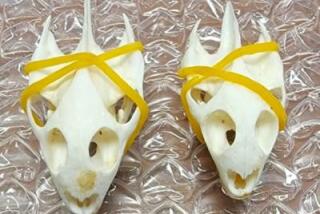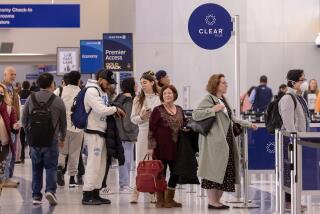Cargo screening finally taking off
SAN FRANCISCO — It’s been a vexing, if little publicized, dilemma in the years after the Sept. 11, 2001, terrorist attacks: The thorough screenings that passengers’ bags are subjected to do not extend to most cargo hoisted into the bellies of airliners.
Lawmakers hope to change that soon, starting with a pilot program this summer in a drafty hangar at San Francisco International Airport. Here, with the help of a new, $8-million sorting facility, flowers, machine parts, personal computers and myriad other goods bound for passenger aircraft will come under greater scrutiny than ever.
Officials hope the six-month program will help them figure out how to inspect more cargo on passenger jets for explosives without slowing time-sensitive shipments. Getting products to customers quickly is crucial for U.S. businesses to remain competitive and delivers up to $5 billion a year in worldwide revenue for the airlines.
“We want to prove we can screen significantly more cargo than we do presently without interfering with the stream of commerce,” said Douglas Bauer, an executive at the Department of Homeland Security’s Directorate for Science and Technology. “We also want to capture what costs are associated with screening significantly more cargo.”
Some cargo on passenger jets already passes through several layers of screening, but for the most part it isn’t as rigorous as the explosives-detection systems, X-ray machines and searches applied to travelers and their luggage.
Federal lawmakers, who ordered the pilot program last year, expect it to help officials figure out how to inspect containers on large pallets for explosives with technology that has been designed to scan individual pieces of luggage. Systems that can screen all types of cargo don’t exist.
Although the terrorist attacks changed air travel forever, most of the approximately 6 billion pounds of cargo shipped aboard passenger aircraft within the U.S. each year is not inspected thoroughly, according to a 2005 report by the Government Accountability Office, the investigative arm of Congress.
The Transportation Security Administration, the federal agency created after the skyjackings to revamp aviation security, does not reveal how much cargo on passenger jets is screened, citing security concerns.
“When they don’t tell us what percentage of air cargo is being inspected, they’re implicitly telling us that air cargo is a much bigger risk,” said Michael O’Hanlon, a senior fellow at the Brookings Institution. “They’re implicitly saying that ‘Al Qaeda loves to go after airplanes, so we’re not going to tell you how much air cargo is being inspected.’ ”
Congress is considering legislation that would require the TSA to screen all cargo on passenger aircraft by 2009. About half the baggage compartment on a passenger plane is set aside for unaccompanied cargo. Goods shipped on all-cargo aircraft would not receive the same scrutiny because travelers wouldn’t be aboard.
The TSA says cargo currently destined for passenger aircraft must pass through several layers of security. That includes requirements that all individual packages checked at airports be inspected, that airlines establish business relationships with companies that provide them goods and that bomb-sniffing dogs monitor some shipments.
“All cargo carried on passenger planes is only handled by companies that have security programs that have met our requirements,” said Nico Melendez, a TSA spokesman. “These companies are subject to our inspections to make sure they’re complying with the rules.”
However, the GAO report found significant vulnerabilities in the TSA’s “known shipper” program, including reliability of information provided by the companies and how the agency identifies shippers that may pose a risk. The TSA says it is addressing those issues.
In the San Francisco International Airport pilot program, the Directorate for Science and Technology is working with the TSA, several airlines, airport officials and Lawrence Livermore National Laboratory to inspect six times more cargo than is being screened now.
To do so, officials built the sorting facility and trained a special contingent of security screeners to take apart most pallets and load goods into explosives-detection equipment.
Different technologies will be used to scan goods of varying shapes and sizes. Paper, for example, will be put through a different system than fruit or vegetables. Then screeners must reassemble the boxes and crates in time for their flights. The facility is expected to open in June.
“We’re gaining an understanding of where the gaps are in the technology,” said Amy Waters, a scientist at Lawrence Livermore and a manager for three pilot programs nationwide. “There could be improvements in algorithms for detection of explosives that we identify.”
For companies that handle air freight, plans to deconstruct pallets raise liability concerns, and federal officials have urged airlines to obtain insurance.
“We certainly would not want to see a hand inspection program come out where all the resources and money the TSA has are focused on people ripping open boxes and creating warranty issues,” said Brandon Fried, executive director of the Airforwarders Assn., which represents the air cargo industry. “There are experts that do nothing but spend time configuring containers to minimize damage to high-tech goods -- especially out of San Francisco.”
Air cargo ferried on passenger aircraft contains primarily high-tech goods that are critical to just-in-time manufacturing, as well as perishable commodities such as fish, fruit, vegetables, flowers and medical supplies.
Federal officials also are conducting a pilot program at Cincinnati/Northern Kentucky Airport, where next month security screeners will begin using existing facilities to see how much cargo can be checked for explosives.
At Seattle-Tacoma International Airport, officials started searching last fall for stowaways among goods destined for cargo aircraft, using technology designed to detect human heartbeats and carbon dioxide. Homeland Security is scheduled to report findings of all three pilot programs to Congress by the end of the year.
Air cargo representatives are skeptical that findings from these programs can be applied uniformly to the nation’s diverse commercial airports and question how widespread inspections would be funded.
“If they’re building a stand-alone facility at an airport, will every airport have the luxury of being able to erect a similar structure?” asked Fried of the Airforwarders group.
“It’s safe today, and safe because there isn’t a reliance on a magic bullet; they use a lot of things,” he added. “You look at past history, and nothing has happened.”
But security experts disagree that today’s air cargo screening system is failsafe simply because terrorists haven’t used goods shipped by air as a weapon.
“I would be extremely critical of the logic that says ‘Since we haven’t had an attack yet, we can be confident our system is working.’ That is irresponsible,” said O’Hanlon of the Brookings Institution.
Lawmakers say they’re concerned that the San Francisco pilot program has taken too long to get off the ground; they expect to hold hearings on it this summer. Participants say ever-changing federal security regulations, the complexity of designing a new cargo handling system and the number of entities involved slowed the process.
“I knew from the outset that this was going to be a very complex undertaking,” said Homeland Security’s Bauer. “When you step back from doing these pilots, you have an appreciation of how complex our country is. There are 448 airports out there.”
More to Read
Sign up for Essential California
The most important California stories and recommendations in your inbox every morning.
You may occasionally receive promotional content from the Los Angeles Times.










